Table of contents
General Meaning of Lucky Cat
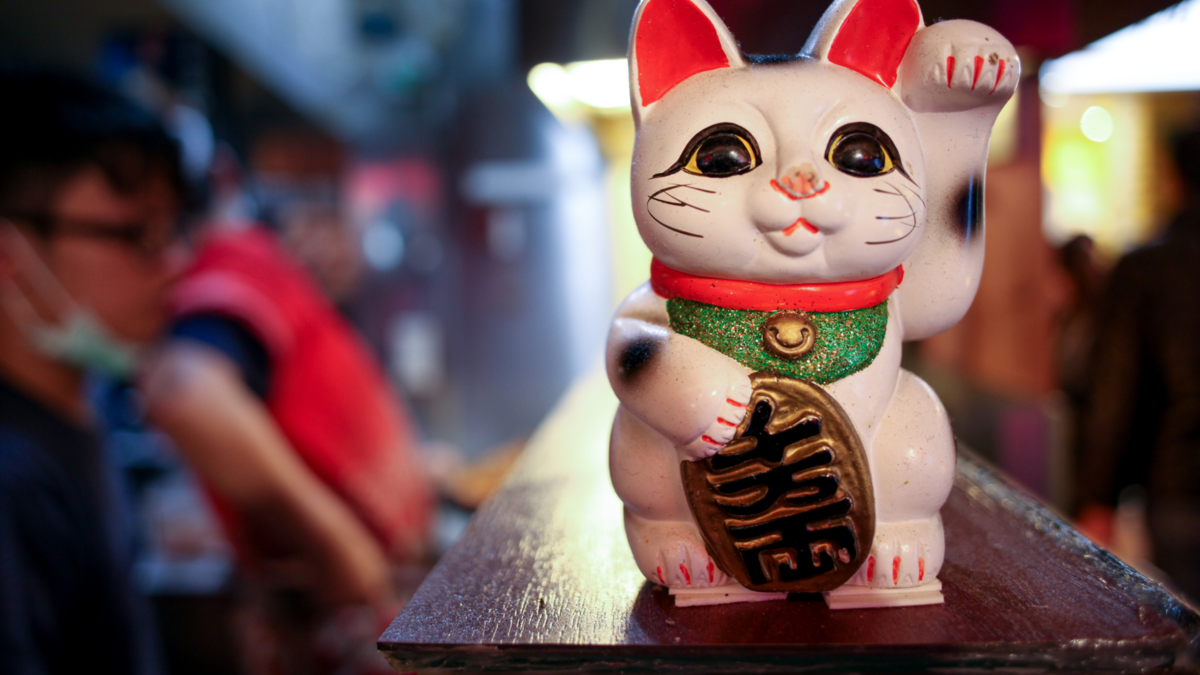
The Lucky Cat or Maneki-Neko is one of the most traditional amulets in Japan. The waving cat can be seen in shops, restaurants and businesses in general, always next to the cash register. For, this talisman with its raised paw is believed to attract money, prosperity and good customers.
However, depending on the position of the paw that is raised, it brings a different meaning. If the left paw is raised, it attracts good customers; but if it is the right paw, it will attract good luck and prosperity. The colours of the Lucky Cat are also determinant in achieving its goals.
Throughout this article, we will show you the legends that gave origin to the Maneki-Neko, historical events, ways to use it as decoration and where you can find this talisman that brings so much happiness to those who own it. To know everything about the Lucky Cat, keep reading.
Lucky cat, meaning, characteristics and uses in decoration
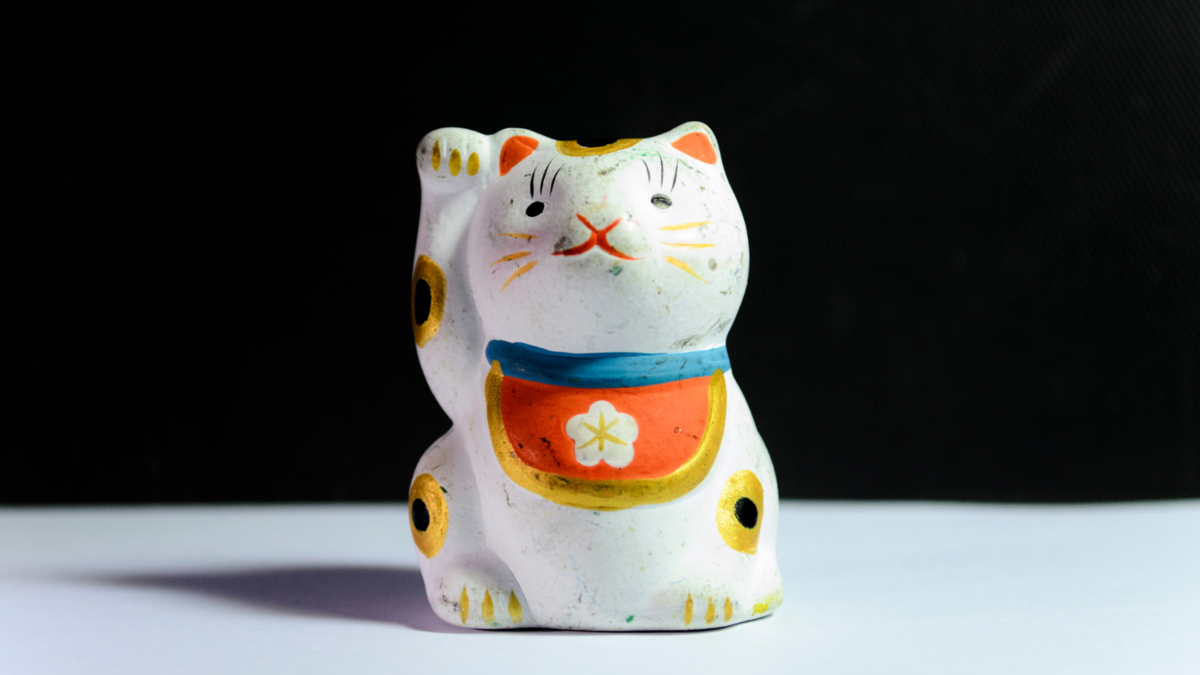
Learn, in this topic, what are the characteristics and the meaning of one of the most popular amulets in Japan and in the world: the Lucky Cat or Maneki-Neko. Also learn how to use it in the decoration of your home or business, besides choosing the ideal cat for your purpose. Check it out below.
Maneki-Neko, the Lucky Cat
Maneki-Neko, the Lucky Cat, originated in Japan in the Edo period (1602 to 1868), and the amulet originated through the millennial cat breed Bobtail. The translation for Maneki-Neko is literally "the cat that waves", as it was believed that it waved at people. However, the cat was just cleaning itself or playing.
Cats are sensitive animals and at the slightest sign of danger, but they are always on the alert. Therefore, their gestures are understood as an omen or a sign, for example. It is not known for sure how and when the statue was made. However, there are many legends and stories that ensure that the Lucky Cat is a powerful amulet to conquer your goals.
The Meaning of Lucky Cat
The Lucky Cat has a very important meaning to the Japanese and Chinese. They believe that the Maneki-Neko can bring financial abundance, prosperity and good luck. The amulet is often used to attract customers to their businesses, restaurants or in the workplace to protect finances.
However, besides attracting wealth, the Lucky Cat attracts good energies, improves relationships, protects against bad energies and from diseases. Therefore, the Maneki-Neko has become an extremely essential object to have at home, together with you or in places that need to be protected.
Characteristics of the figure
The Maneki-Neko is a statue of a cat, they are usually white, and are with one paw raised, have big eyes and a rounded face. Another characteristic inherited from the period in which it originated is that at that time cats were expensive and in order not to lose them, hi-chiri-men (red luxurious cloth) were worn along with a bell around the neck.
In addition, the lucky cat has several versions, and the most traditional is the cat with one paw raised and the other paw holding a gold coin, the Koban. As it became popular, Maneki-Neko can be found in different sizes, shapes and colors, each serving to achieve a personal goal. Also, depending on which paw is raised, it will have a different meaning.
The meaning of hand placement
The position of the paws of the Maneki-Neko has different meanings and purposes. If the lucky cat has its paw raised, it will attract good customers and maintain good relationships. The right paw raised serves to attract prosperity, fortune and good luck.
There is also the Maneki-Neko with both paws raised. This version is harder to find, but it symbolizes protection, luck, financial abundance and attracts people. In addition, the higher the paw is raised, the more money and customers are attracted.
The meaning of colors
The colors of Maneki-Neko also have a strong influence on what you wish to attract to your life and your trade, which are:
White: Joy, purification and attracts good energy;
Black: Protects against bad vibes and evil spirits;
Green: Attracts luck for those who are studying;
Red: Attracts protection against disease;
Pink: Lucky in love and relationships;
Golden: Attracts fortune and good customers;
Blue: To protect drivers;
Colored: It is considered the one that attracts the most luck.
The meaning of that which wears or holds
The Maneki-Neko is usually adorned with a red collar with a small bell, widely used at the time by court ladies to keep an eye on the cat. As a figurine, it is common for the lucky cat to hold a koban (a coin from the Edo period). However, it was a coin of little value, and in the Maneki Neko the koban is worth ten million, that means it is just a symbol to attract fortune.
In addition, there are specimens of the Maneki-Neko holding a magic hammer, which represents money and wealth. A carp, which symbolizes good luck and prosperity, and a marble which attracts money. It is believed to be a crystal ball which is associated with wisdom.
The day of the Maneki-Neko
Maneki-Neko Day is celebrated on September 29th, with various festivals scattered throughout Japan, such as in Mie City, Seto, Shimabara, and Nagasaki. However, Lucky Cat Day is also celebrated on other dates depending on the location.
The date was chosen because of a numerical pun. Nine is ku in Japanese. September, which is the month nine, became kuru, which represents the verb to arrive. The number two is called futatsu and one pays only the first syllable, fu. In this way, twenty-nine becomes fuku, which means luck, prosperity and wealth. Thus, 9.29 symbolizes kuru fuku, which roughly means "The luck that comesthrough the cat of happiness."
How to use the Lucky Cat in decoration
The Lucky Cat, besides bringing luck, prosperity and good energies, is a very elegant decorative piece that can be used in any environment. However, it is indicated to place the Maneki-Neko in a high point so that it is in evidence; and facing the entrance, whether of your home or of your business establishment.
There are many varieties of Maneki-Neko to decorate your home or business, you can find the Lucky Cat made of ceramic, porcelain and some electronic models, where the cat moves both paws. Another way to use the Maneki-Neko is through keychains, safes or key rings.
Bobtail, the "Maneki-neko" breed
It is believed that the bobtail breed appeared around 1600, in the Edo period, and its ease of hunting rats and pests made it such a popular and valued animal. The Maneki-Neko is of the bobtail cat breed and is distinguished by its tail, which looks like a pom-pom. However, this characteristic is due to a genetic mutation.
The bobtail breed is one of the most traditional in Japan and they are intelligent and very docile felines. They love to interact with their owners, play in the water and are easy to live with other animals, especially dogs.
Legends, historical events and origin of the Lucky Cat
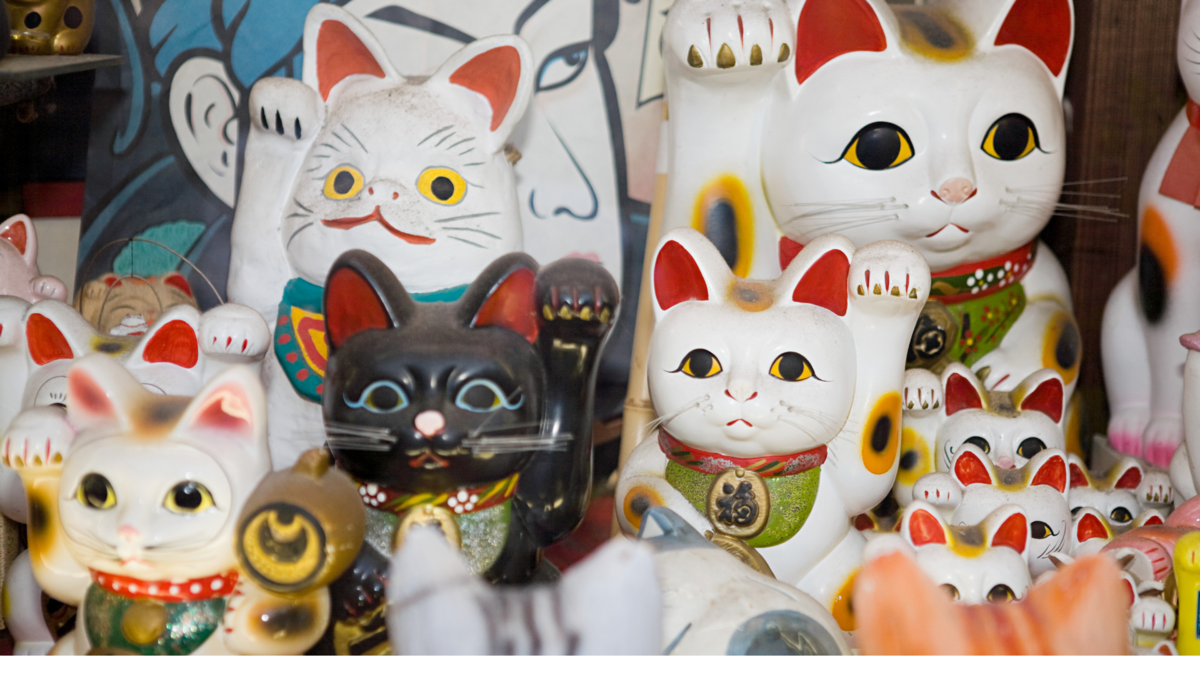
There are many legends that tell how the Lucky Cat came to be. However, real and imaginary stories get mixed up, causing more mysteries behind the emergence of the Maneki-Neko. Below, learn about some legends and historical events and the origin of the Lucky Cat.
The Legend of the Gōtoku-ji Temple Cat
The story is told that at Gōtoku-ji Temple, there lived a monk and his kitten. One day, a noble man took shelter under a large tree near the temple during a heavy rainstorm. Suddenly, the man's attention was drawn to the kitten, which seemed to beckon to him.
Intrigued, he went to meet the cat and, as he walked away from her shelter, lightning struck the tree. From then on, the man understood that the gesture saved his life and began to give donations to the temple, where he became prosperous and visited by everyone in the region. In addition, the nobleman ordered a huge statue to be made in gratitude to the cat.
The legend of the shrine of Imado
According to the legend, there lived in Imada, in the Edo period, a lady with her kitten. She was going through many financial difficulties and had nothing to eat for herself and her cat, so she decided to donate him so that he would not die of hunger. When she went to bed, she asked the gods for help to get out of that situation and dreamed about her cat.
During her dream, the cat directed her to make clay statues with its image, as it would bring luck. The next morning, the lady produced the statue and, noticing her cat washing her face, she decided to mold the cat with its paw raised. The old woman managed to sell the first image and many others. From that, she prospered and lived without difficulty.
The Geisha and the cat
Geisha was a beautiful young girl full of talents and lived with her kitten. Very docile and companion, he loved to play with the girl. While Geisha was wearing her kimono, the cat jumped up and tore all her clothes.
Thinking that the geisha was being attacked, a man approached and with his sword cut off the kitten's head. However, despite the sad situation, the cat's body fell on the claws of a snake that was about to attack the girl. Distraught at losing her kitten, she won a statue of her cat from her client.
Historical events and the luck brought by cats
There are many events throughout history that prove the luck cats bring. In the Edo period (1602 to 1868), the Emperor ordered cats to be set free, as their hunting skills could control rodents and other pests that were plaguing the country's agriculture and sericulture.
Even after the decline of the textile industry in Japan, cats have become sacred animals that bring good luck and they are believed to signal danger by their gestures. Thus, the lucky cat statue has come to be considered as an amulet that brings prosperity and with its raised paw calls customers to the city's businesses.
Over the years, the Maneki-Neko has become an indispensable talisman in shops, restaurants, and especially in homes. And for each purpose it is possible to find the statue in different colors and positions of the paws.
Origins in the Meiji period and expansion in the 1980s-1990s
During the Meiji period (1868 to 1912), the Maneki-Neko statues became popular. And with the intention of expanding the amulet to other countries, the government created a law in 1872 that prohibited any talisman that made reference to something obscene. To replace these ornaments, the Maneki-Neko was placed everywhere and quickly spread throughout Asia.
Between 1980 to 1990, many Japanese migrated to the United States and took their culture and customs with them. The "Cool Japan" era helped to further spread the presence of Maneki-Neko in the West.
Where you can see specimens of Maneki-Neko
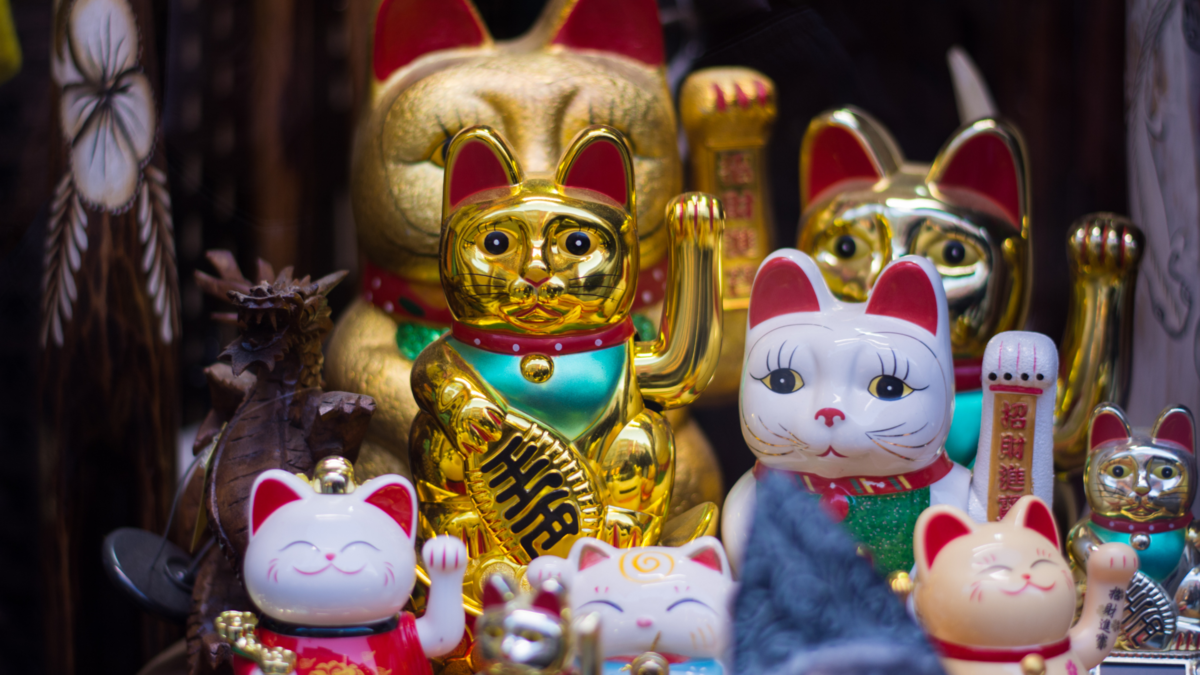
The popular Maneki-Neko has spread around the world and gained museums and temples in its honor, so you will see below where it is possible to see specimens of the Lucky Cat, see below.
Manekineko Art Museum in Okayama (Japan)
In Okayama, the Manekineko Art Museum has more than 700 statues of the lucky cat. In addition, it is possible to find several specimens from the Meiji period in different materials and shapes.
Manekineko-Dori Street in Tokoname (Japan)
Manekineko-Dori Street (Waving Cat Street) is located in Tokoname, where you can find several statues of the lucky cat scattered all over the street. In addition, to honor Maneki-Neko, a giant statue, about 3.8 meters high and 6.3 meters wide, was built in the city.
Lucky Cat Museum in Cincinnati (United States)
Popular around the world, the Maneki-Neko cat has been given a lucky cat museum in Cincinnati, USA, where you can find over two thousand images of this lucky charm, as well as various activities to interact with the feline.
The Lucky Cat in popular culture
In popular culture, the lucky cat is present in several media products, fashion and art. One example is Hayao Miyazaki's anime, Kingdom of Cats, in which the main character wins a reward for saving a cat.
Moreover, those who play with Meowth, represented by a cat with a coin on top of its head in the Pokémon game, earn money for each battle won. Therefore, the Maneki-Neko or lucky cat has become not only an amulet that brings wealth and prosperity, but also a figure that is part of our daily lives.
Besides the Lucky Cat, what other amulets are popular in Japan?
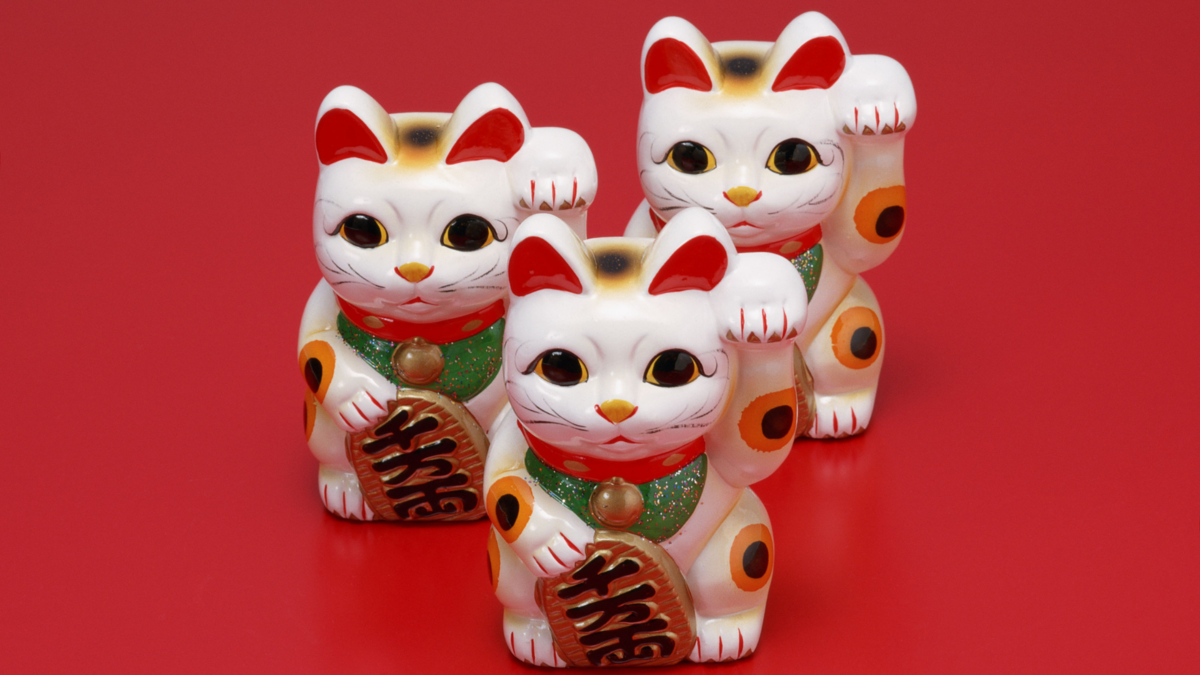
As in other cultures, Japan has a plethora of amulets that are believed to bring luck, protection, prosperity and happiness. Besides the Lucky Cat, as presented throughout this article, there are many other popular amulets.
Daruma is a doll made of papier-mâché, also known as Bodhidharma. Its eyes are not painted, because you have to make a request to paint one of the eyes and when your goal comes true you can fill in the other eye. However, superstition says that the doll must be won.
Another very popular amulet is the Omamori, meaning "protection", which are little bags containing a blessing, and the Akabeko is a toy for children that protects them against illness. Also, the Tsuru is considered a sacred bird in Japan because it can live up to a thousand years. According to legend, if you make a thousand origami tsurus, your requests will be fulfilled.
However, there are many other amulets that are just as important to the Japanese people.

